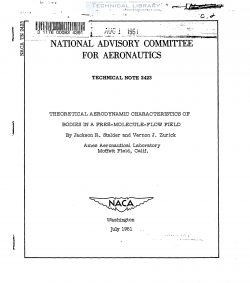naca-tn-2423
- Version
- 61 Downloads
- 1.22 MB File Size
- 1 File Count
- December 15, 2016 Create Date
- December 15, 2016 Last Updated
National Advisory Committee for Aeronautics, Technical Notes - Theoretical Aerodynamic Characteristics of Bodies in a Free Molecule Flow Field

An analytic investigation is made of the aerodynamic coefficients of
various bodies located in a freeemolecule—flow field. These bodies are
the following: flat plate, cylinder, sphere, and cone. Calculations are
performed using values of molecular speed ratio (ratio of stream speed to
most probable molecular speed) ranging from 0 to 20. '
The aerodynamic coefficients of a cone are calculated for angles of
attack ranging from 0° to 60°. The semivertex angles of the cones investi—
gated vary from 2.5° to 30°.
The calculations are performed assuming two types of molecular
reflection, specular and diffuse; in addition, for the cone, a third type
of molecular reflection, wherein impinging molecules are not re—emitted
from the body but are swept along its surface, is postulated in order to
compare the drag coefficients calculated by free—molecule—flow theory with
values obtained from continuum theory.
Consideration of the problem of the flight of highrspeed long—range
aircraft has indicated that skin temperature and drag forces may be
considerably reduced by operation at high altitudes. Consequently, it
becomes of interest to determine the aerodynamic forces arising from high—
speed flight at high altitudes. Flight at altitudes where the molecular—
meanrfree path is larger than a characteristic body dimension is in the'
free-molecule—flow regime. Molecular-meanrfree path as a function of
altitude is given in reference 1. (At an altitude of 75 miles, the mean?
free path is about 1 foot.) Calculations relating skin temperature,
altitude, and velocity have previously been cdmpleted in reference 1;
drag forces, however, were not computed.
Analytic inVestigations of the drag forces acting on simple body
shapes in free—molecule flow have been reported in references 2, 3,m
h, while experimental investigations have been described in references.
In all these analyses, it was assumed that the gas molecules haVe a
Maxwellian distribution of thermal velocity superimposed upon the mass
velocity. This assumption is likewise made in the present paper.
Heineman (reference 2) and Ashley (reference 3) have calculated the aero—
dynamic coefficients for various body shapes including the flat plate,
sphere, cylinder, and cone. However, the expressions for the drag COef—
ficients of the sphere and cylinder were not integrated by Heineman,
while Ashley's solution for the cylinder was not expressed in closed
form. Also, in both papers, the drag coefficients for the conical bodies
were calculated only for the special case of zero angle of attack.
| File | Action |
|---|---|
| naca-tn-2423 Theoretical Aerodynamic Characteristics of Bodies in a Free Molecule Flow Field.pdf | Download |
Comment On This Post